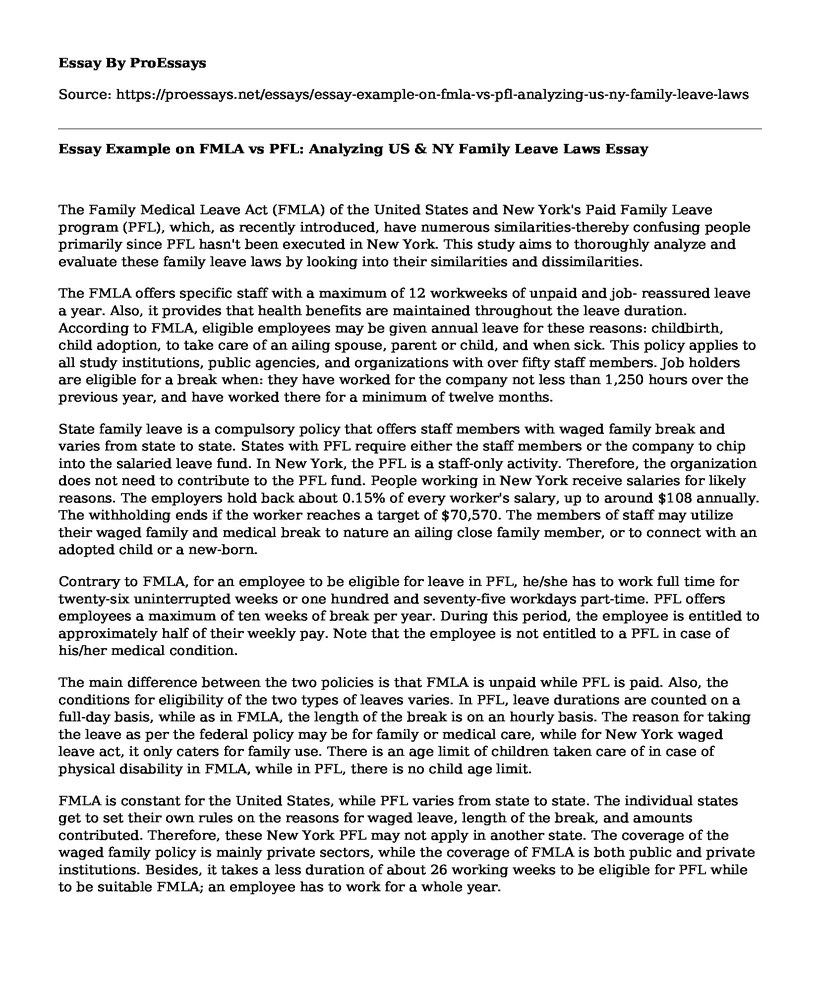The Family Medical Leave Act (FMLA) of the United States and New York's Paid Family Leave program (PFL), which, as recently introduced, have numerous similarities-thereby confusing people primarily since PFL hasn't been executed in New York. This study aims to thoroughly analyze and evaluate these family leave laws by looking into their similarities and dissimilarities.
The FMLA offers specific staff with a maximum of 12 workweeks of unpaid and job- reassured leave a year. Also, it provides that health benefits are maintained throughout the leave duration. According to FMLA, eligible employees may be given annual leave for these reasons: childbirth, child adoption, to take care of an ailing spouse, parent or child, and when sick. This policy applies to all study institutions, public agencies, and organizations with over fifty staff members. Job holders are eligible for a break when: they have worked for the company not less than 1,250 hours over the previous year, and have worked there for a minimum of twelve months.
State family leave is a compulsory policy that offers staff members with waged family break and varies from state to state. States with PFL require either the staff members or the company to chip into the salaried leave fund. In New York, the PFL is a staff-only activity. Therefore, the organization does not need to contribute to the PFL fund. People working in New York receive salaries for likely reasons. The employers hold back about 0.15% of every worker's salary, up to around $108 annually. The withholding ends if the worker reaches a target of $70,570. The members of staff may utilize their waged family and medical break to nature an ailing close family member, or to connect with an adopted child or a new-born.
Contrary to FMLA, for an employee to be eligible for leave in PFL, he/she has to work full time for twenty-six uninterrupted weeks or one hundred and seventy-five workdays part-time. PFL offers employees a maximum of ten weeks of break per year. During this period, the employee is entitled to approximately half of their weekly pay. Note that the employee is not entitled to a PFL in case of his/her medical condition.
The main difference between the two policies is that FMLA is unpaid while PFL is paid. Also, the conditions for eligibility of the two types of leaves varies. In PFL, leave durations are counted on a full-day basis, while as in FMLA, the length of the break is on an hourly basis. The reason for taking the leave as per the federal policy may be for family or medical care, while for New York waged leave act, it only caters for family use. There is an age limit of children taken care of in case of physical disability in FMLA, while in PFL, there is no child age limit.
FMLA is constant for the United States, while PFL varies from state to state. The individual states get to set their own rules on the reasons for waged leave, length of the break, and amounts contributed. Therefore, these New York PFL may not apply in another state. The coverage of the waged family policy is mainly private sectors, while the coverage of FMLA is both public and private institutions. Besides, it takes a less duration of about 26 working weeks to be eligible for PFL while to be suitable FMLA; an employee has to work for a whole year.
Conclusion
In my opinion, New York salaried Parental Leave Policy ought to be improved by increasing the amount of compensation during leave, employees chipping into the PFL fund, and loosening up the conditions for leave eligibility. As per the class notes, work and family life are interconnected. The two relate in that the output of an employee at work depends on their stability at home. Besides, work provides a source of income for employees. There is a spillover effect whereby problems at home hinder job performance (negative spillover) or family obligations motivating employees to work harder (positive spillover). Bettering the Paid Parental leave Policy will lead to positive spillover.
Works Cited
"FMLA Frequently Asked Questions." U.S. Department of Labor, www.dol.gov/agencies/whd/fmla/faq.
"New York State." Paid Family Leave, paidfamilyleave.ny.gov/.
"Paid Family Leave Policies And Population Health." 2019, doi:10.1377/hpb20190301.484936.
"The Passage of the National Family and Medical Leave Act (FMLA)." Getting Paid While Taking Time, 2016, pp. 29-67., doi:10.2307/j.ctvrdf2t7.5.
Cite this page
Essay Example on FMLA vs PFL: Analyzing US & NY Family Leave Laws. (2023, Jun 06). Retrieved from https://proessays.net/essays/essay-example-on-fmla-vs-pfl-analyzing-us-ny-family-leave-laws
If you are the original author of this essay and no longer wish to have it published on the ProEssays website, please click below to request its removal:
- Clinton's United Nations 4Th World Conference Speech
- Summary Reaction to Brene's Talk on Connection Between Our Friends and Family
- Essay on Reaping Benefits of Disabled Worker Diversity: Tangible Benefits of Hiring Disabled Employees
- Essay on Walter Jordan: Negligence of Arizona Department of Correction Led to Skin Cancer Death
- Essay Example on Trump's Impeachment: American Citizens Weigh In
- Essay Sample on Olmecs: Mexico's Ancient Rubber People
- Criminal Justice System: Racially Biased and Problematic - Free Research Paper Sample







